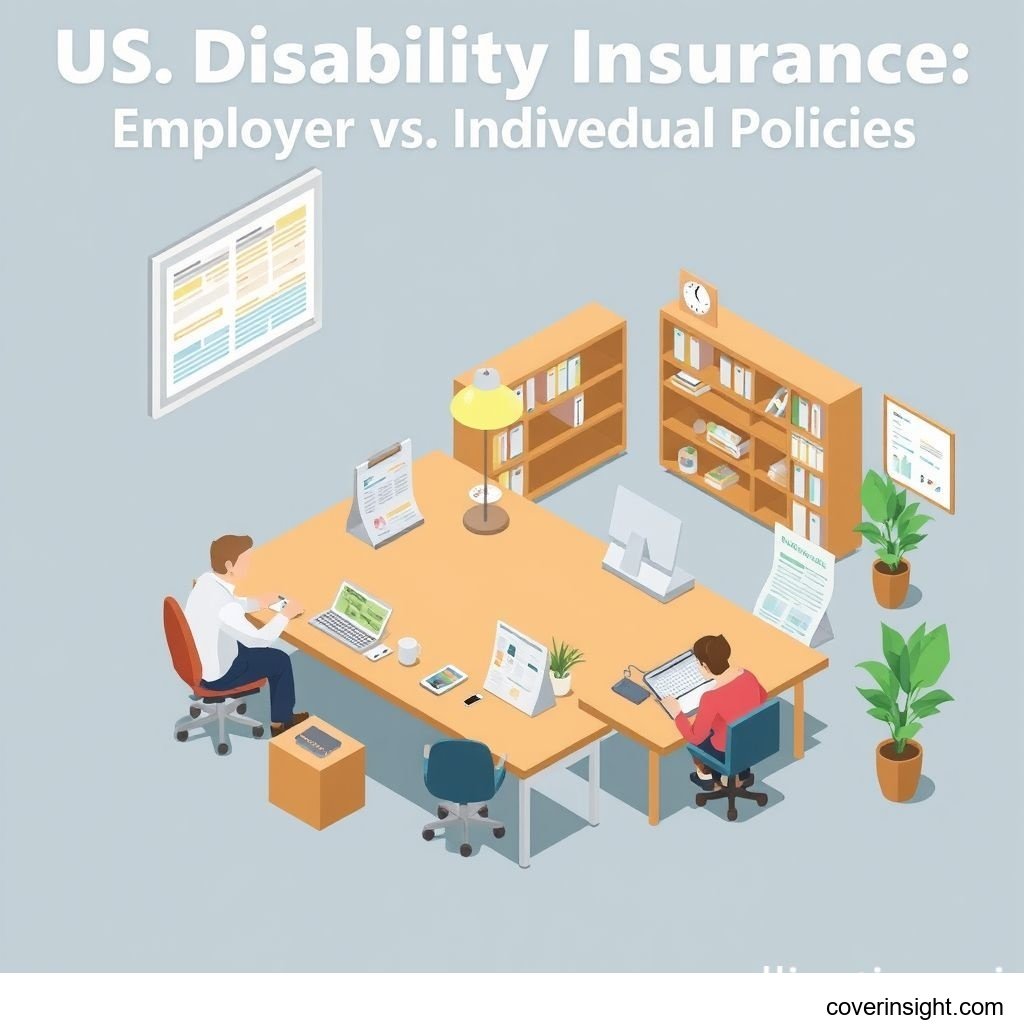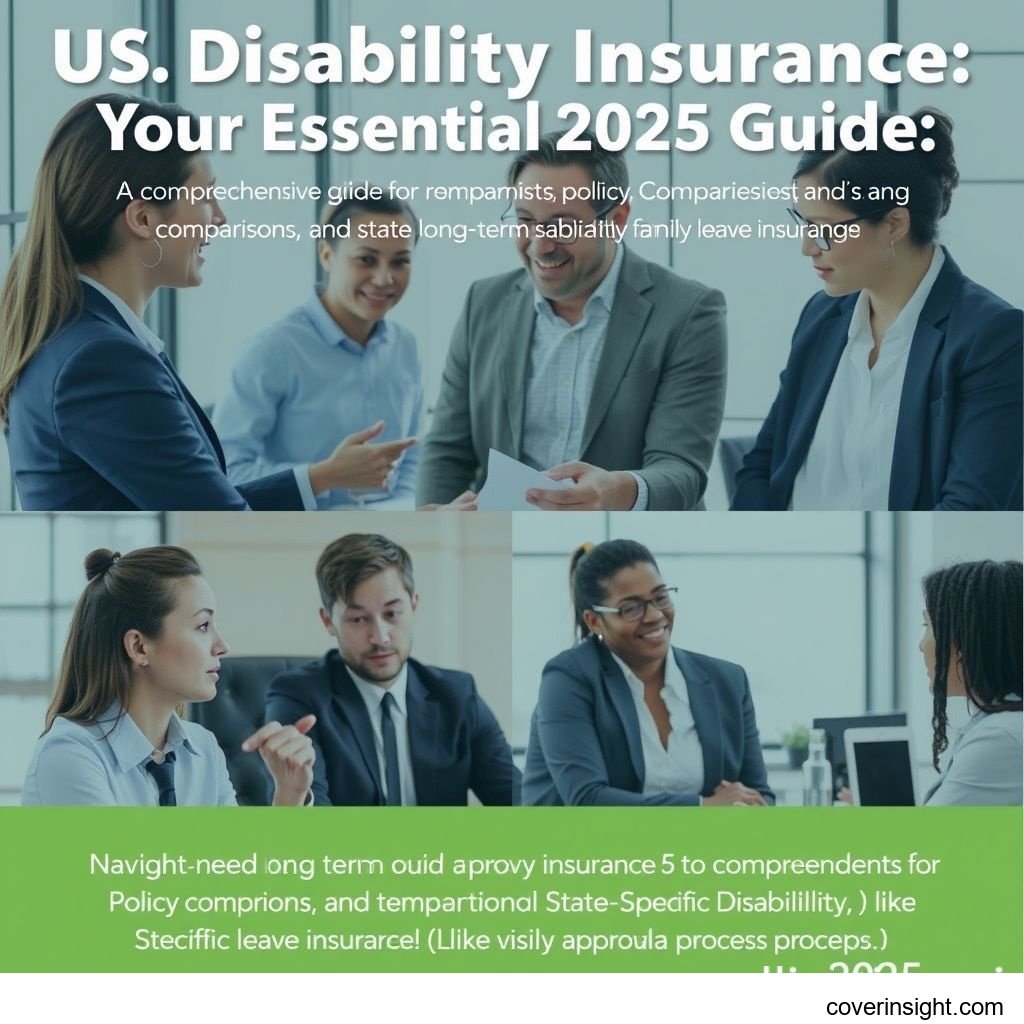Introduction
Preparing for the unexpected is a cornerstone of financial security, and understanding how to apply for disability insurance in US (2025) is a crucial step for many Americans. Disability insurance provides a vital safety net, replacing a portion of your income if you become unable to work due to illness or injury. In 2025, navigating the various policy options, eligibility requirements, and application procedures requires a clear, informed approach. This guide aims to demystify the process, helping you secure coverage that protects your livelihood and provides peace of mind for you and your family. Whether you're considering individual policies or employer-sponsored plans, knowing how to apply for disability insurance effectively can make all the difference in unforeseen circumstances.
Coverage Details
Disability insurance isn't a one-size-fits-all product. Understanding what various policies cover, and equally important, what they don't, is essential when you consider how to apply for disability insurance. This section delves into the typical inclusions and common exclusions you'll encounter.
What’s Included
Most disability insurance policies are designed to replace a percentage of your pre-disability income, often ranging from 50% to 70%. The specifics of what's included can vary significantly.
Key inclusions typically are:
-
Benefit Period: This defines how long you will receive benefits. Common periods include 2 years, 5 years, to age 65, or for life. Longer benefit periods generally come with higher premiums.
-
Waiting Period (Elimination Period): This is the time between when your disability begins and when your benefits start. Typical waiting periods are 30, 60, 90, or 180 days. A shorter waiting period usually means higher premiums.
-
Definition of Disability: This is arguably one of the most critical aspects.
-
"Own Occupation" Disability: Pays benefits if you cannot perform the duties of your specific job, even if you can perform other types of work. This is generally more expensive but offers broader protection.
-
"Any Occupation" Disability: Pays benefits only if you cannot perform any job for which you are reasonably suited by education, training, or experience. This is less expensive but offers less protection.
-
"Modified Own Occupation": A hybrid definition, often paying benefits if you cannot perform your own job, and are not engaged in any other occupation.
-
-
Partial Disability Benefits: Many policies offer benefits if you can work part-time but are still limited by your disability, providing a percentage of your full benefit.
-
Cost of Living Adjustment (COLA) Rider: An optional feature that increases your benefit payment over time to account for inflation, which can be particularly valuable for long-term disabilities.
-
Future Increase Option (FIO) Rider: Allows you to increase your coverage in the future without additional medical underwriting, provided your income increases.
Common Exclusions
While comprehensive, disability insurance policies do have limitations. When learning how to apply for disability insurance, be aware of what might not be covered.
Typical exclusions include:
-
Pre-existing Conditions: Conditions you had before purchasing the policy might be excluded or subject to a waiting period before coverage applies. Always disclose existing conditions during the application.
-
Self-Inflicted Injuries: Injuries resulting from intentional self-harm or attempted suicide are almost universally excluded.
-
War or Acts of War: Disabilities sustained as a direct result of war, declared or undeclared, are typically not covered.
-
Participation in Illegal Activities: Injuries or illnesses sustained while committing a felony or engaging in other illegal acts are excluded.
-
Normal Pregnancy and Childbirth: While complications of pregnancy may be covered, normal pregnancy and childbirth are generally not considered a disability, though some policies may offer limited maternity leave benefits.
-
High-Risk Activities: Some policies may exclude disabilities arising from certain high-risk hobbies (e.g., professional racing, skydiving) unless specific riders are added or explicitly covered.
It's crucial to review the policy document thoroughly, paying close attention to the "Definitions" and "Exclusions" sections. Consulting with a licensed insurance professional can help clarify these nuances when you explore how to apply for disability insurance.
Cost Analysis
Understanding the factors that influence the cost of disability insurance is a critical component of knowing how to apply for disability insurance smartly. Premiums can vary widely based on individual circumstances and policy choices.
Price Factors
Several key elements determine the premium you will pay for your disability insurance policy.
These factors include:
-
Age: Generally, the younger you are when you purchase a policy, the lower your premiums will be. Premiums increase with age due to higher health risks.
-
Health and Medical History: Your current health status, past medical conditions, and family medical history are significant determinants. Applicants with pre-existing conditions or a history of serious illness may face higher premiums or exclusions.
-
Occupation: Your profession plays a major role. Occupations are typically categorized by risk level:
-
Class 1 (Low Risk): Office workers, accountants, lawyers. Lower premiums.
-
Class 4/5 (High Risk): Construction workers, surgeons, police officers. Higher premiums.
-
-
Income: The higher the percentage of your income you want to replace, the higher your premium will be.
-
Policy Features and Riders: Adding optional benefits like a Cost of Living Adjustment (COLA) or Future Increase Option (FIO) rider will increase your premium.
-
Benefit Period: The longer the period you wish to receive benefits (e.g., to age 65 vs. 2 years), the higher the cost.
-
Waiting Period (Elimination Period): A shorter waiting period (e.g., 30 days) means a higher premium, as benefits would start sooner. A longer waiting period (e.g., 180 days) reduces the premium.
-
Definition of Disability: "Own occupation" coverage is more expensive than "any occupation" coverage due to its broader protection.
Saving Tips
While disability insurance is an investment, there are strategies to manage its cost without compromising essential coverage. Considering these tips can help you decide how to apply for disability insurance within your budget.
Effective ways to save on premiums include:
-
Buy Young: Purchasing a policy when you are younger and healthier locks in lower rates for the long term.
-
Opt for a Longer Waiting Period: Choosing a 90 or 180-day waiting period instead of 30 or 60 days can significantly reduce your premiums. Ensure you have sufficient emergency savings to cover this initial period.
-
Choose "Any Occupation" (with Caution): While "own occupation" is ideal, if budget is a primary concern, an "any occupation" definition can be less expensive. Understand its limitations thoroughly.
-
Prioritize Core Coverage: Focus on the essential benefit amount and period. Add riders only if they align with your long-term financial plan and budget.
-
Group vs. Individual Policies: Explore employer-sponsored group plans first, as they are often more affordable and may not require medical underwriting. However, individual policies typically offer more robust coverage and portability.
-
Maintain Good Health: A healthier lifestyle can positively impact your medical underwriting and potentially lead to lower premiums.
-
Shop Around: Obtain quotes from multiple reputable insurance providers. Prices for similar coverage can vary. The National Association of Insurance Commissioners is an excellent resource for finding state-specific information and reliable insurers.
Application Process for Disability Insurance
Understanding how to apply for disability insurance involves more than just selecting a policy; it requires navigating eligibility criteria and a comprehensive application journey. Preparing for this process is key to securing timely coverage.
Eligibility Requirements
Before you even begin to apply for disability insurance, it’s vital to understand the common eligibility criteria set by insurers.
Typically, eligibility is based on:
-
Age: Most insurers have minimum and maximum age limits for applying, usually between 18 and 60-65 years old.
-
Employment Status: You must be actively employed and earning an income. Some policies have minimum income requirements.
-
Residency: You generally need to be a U.S. resident or citizen.
-
Health: Insurers will assess your current health, medical history, and sometimes family medical history. Healthy applicants usually receive the best rates and broader coverage.
-
Occupation: As mentioned, your profession's risk level will impact eligibility and cost. Some very high-risk occupations might be uninsurable with certain carriers.
-
Financial Standing: Insurers often want to see a stable financial history, ensuring your income level justifies the benefit amount requested. They typically limit the benefit to a percentage of your current income to prevent over-insurance.
Steps to Apply
When you're ready to learn how to apply for disability insurance, follow these structured steps to ensure a smooth process.
-
Assess Your Needs:
-
Determine how much income you need to replace (typically 50-70% of your gross income).
-
Decide on your desired waiting period (how long you can self-fund before benefits begin).
-
Choose a benefit period that aligns with your financial planning (e.g., 5 years, to age 65).
-
-
Research and Compare Policies:
-
Look at different types of policies: short-term vs. long-term, "own occupation" vs. "any occupation."
-
Obtain quotes from multiple insurance carriers. Consider working with an independent agent who can compare options from various providers.
-
-
Complete the Application Form:
-
This will require detailed personal information, employment history, and financial data.
-
Be accurate and honest. Misrepresentation can lead to policy voidance.
-
-
Underwriting Process:
-
This is where the insurer assesses your risk. They will review your application, and may:
-
Request a medical exam (blood test, urinalysis, general physical).
-
Request medical records from your doctor.
-
Verify your income and employment.
-
Check your prescription history.
-
-
This process can take several weeks, so patience is key.
-
-
Review the Offer and Policy:
-
Once underwriting is complete, the insurer will issue a policy offer.
-
Carefully review the proposed policy, paying close attention to the definition of disability, exclusions, riders, and premium.
-
Ensure all terms match your understanding and needs.
-
-
Accept the Policy and Pay the First Premium:
- If satisfied, accept the policy and make your initial payment to activate coverage.
Remember, understanding how to apply for disability insurance is about making informed choices that protect your future. For additional comprehensive guidance on various insurance types, visit Insurance Resources Global.
Choosing Your Policy: Employer vs Individual Policies
A significant decision when considering how to apply for disability insurance involves choosing between employer-sponsored plans and individual policies. Both have distinct advantages and disadvantages that can impact coverage, cost, and portability.
Employer-Sponsored Plans
Many employers offer group disability insurance as part of their benefits package. These plans typically simplify how to apply for disability insurance, but they come with specific characteristics.
Advantages of employer-sponsored plans include:
-
Lower Cost: Premiums are often lower because the employer subsidizes a portion or covers the full cost, or because group rates are lower.
-
Easier Qualification: Many group policies offer guaranteed issue coverage, meaning you may not need a medical exam or extensive underwriting. This can be beneficial if you have pre-existing conditions.
-
Convenience: Enrollment is often straightforward, often automatically deducted from your paycheck.
Disadvantages of employer-sponsored plans include:
-
Limited Coverage: Benefit amounts and periods may be fixed and might not fully meet your needs (e.g., only covering 40-60% of your income for a limited duration).
-
"Any Occupation" Definition: Many group plans use an "any occupation" definition of disability, offering less protection than "own occupation" policies.
-
Not Portable: If you leave your job, you typically lose your coverage. This can leave a gap in protection, especially if you develop a health condition that makes individual coverage difficult to obtain later.
-
Tax Implications: If your employer pays the premiums, the benefits you receive are usually taxable. This is a crucial point regarding the tax implications of benefits, which we will discuss further.
Individual Policies
Purchasing an individual disability insurance policy directly from an insurer offers greater flexibility and customization. This is how to apply for disability insurance if you need tailored protection.
Advantages of individual policies include:
-
Customizable Coverage: You can tailor the benefit amount, waiting period, benefit period, and add various riders to suit your specific financial situation and occupation.
-
Stronger Definitions: Individual policies commonly offer "own occupation" definitions, providing more robust protection for specialized professions.
-
Portability: Your policy is yours, regardless of your employment status. It moves with you if you change jobs or careers.
-
Tax-Free Benefits: If you pay the premiums with after-tax dollars, the benefits you receive are typically tax-free. This directly relates to the tax implications of benefits.
-
Guaranteed Renewability: Many policies offer guaranteed renewability or non-cancelable features, ensuring your policy cannot be canceled (as long as premiums are paid) or your premiums increased (for non-cancelable policies).
Disadvantages of individual policies include:
-
Higher Cost: Premiums are generally higher than group policies, as you bear the full cost and the underwriting is individualized.
-
Medical Underwriting: You will almost certainly need to undergo a medical exam and disclose extensive health information. This can make it harder to qualify if you have health issues.
-
Time-Consuming Application: The application and underwriting process can be more involved and take longer.
For a broader perspective on various insurance options in the United States, consider exploring resources like US Insurance Home.
Understanding Tax Implications of Benefits
A crucial aspect to consider when you learn how to apply for disability insurance is the tax implications of the benefits you might receive. The taxability of disability benefits primarily depends on who paid the premiums.
Taxable vs. Non-Taxable Benefits
The tax implications of benefits from your disability insurance can significantly impact your net income during a period of disability.
Key considerations for the tax implications of benefits:
-
Employer-Paid Premiums: If your employer pays the premiums for your group disability insurance policy, any benefits you receive are generally considered taxable income by the IRS. This is because the employer's contribution to your premiums is a non-taxable benefit to you at the time it's paid. Therefore, the payout later becomes taxable.
- Example: If your employer pays your entire premium, and you receive $3,000/month in benefits, that full $3,000 would typically be subject to income tax.
-
Employee-Paid Premiums (After-Tax): If you pay the premiums for your individual disability insurance policy with your own after-tax dollars, the benefits you receive are generally tax-free. This is the most common scenario for individual policies, where you're using money that has already been taxed to pay for the coverage.
- Example: You pay $100/month in premiums from your net income. If you receive $3,000/month in benefits, that full amount would typically be tax-free.
-
Split-Premium Policies: In some cases, the employer and employee might share the cost of the premiums. If this occurs, the benefits received will be partially taxable and partially tax-free, proportionate to who paid which share of the premium.
- Example: If your employer pays 50% of the premium and you pay 50% with after-tax dollars, then 50% of your disability benefits would be taxable, and 50% would be tax-free.
Understanding these tax implications of benefits is vital for accurate financial planning, as it affects the actual amount of income you'll have available during a period of disability. It's always advisable to consult a tax professional for personalized advice regarding your specific policy and financial situation.
FAQs
Navigating how to apply for disability insurance can lead to many questions. Here are answers to some of the most common inquiries.
How much does how to apply for disability insurance cost?
The cost of how to apply for disability insurance varies widely, typically ranging from 1% to 3% of your gross annual salary. For instance, if you earn $60,000 annually, your premiums could be between $600 and $1,800 per year. Factors like your age, health, occupation, benefit amount, and chosen riders significantly influence the final price.
What affects premiums?
Premiums for disability insurance are primarily affected by:
-
Age and Health: Younger, healthier applicants pay less.
-
Occupation: High-risk jobs lead to higher premiums.
-
Income Level: Higher benefits to replace more income mean higher costs.
-
Policy Features: Longer benefit periods, shorter waiting periods, and optional riders (like COLA) increase premiums.
-
Definition of Disability: "Own occupation" coverage is more expensive than "any occupation."
Is it mandatory?
No, disability insurance is not legally mandatory in the U.S. like auto insurance. However, it is highly recommended by financial experts as a crucial component of a comprehensive financial plan, especially for those whose livelihood depends on their ability to work.
How to choose?
When deciding how to choose disability insurance, consider:
-
Your Income Protection Needs: How much of your income would you need to cover essential expenses if you couldn't work?
-
Emergency Savings: How long could you sustain yourself without income? This helps determine your waiting period.
-
Definition of Disability: "Own occupation" is generally preferred for specialized professionals.
-
Benefit Period: How long do you anticipate needing coverage if a long-term disability occurs?
-
Budget: Balance desired coverage with affordable premiums.
-
Consult a Professional: An independent insurance agent can help compare options from various carriers. You can also research state-specific regulations through your State Insurance Departments.
Consequences of no coverage?
The consequences of no disability insurance coverage can be severe:
-
Financial Ruin: Without income, you may deplete savings, liquidate assets, or incur significant debt to cover living expenses.
-
Loss of Home: Mortgage payments can become impossible without income, leading to foreclosure.
-
Inability to Pay Medical Bills: While health insurance covers medical costs, it doesn't replace lost income for daily living. More information on health insurance can be found at Healthcare.gov.
-
Dependence on Others: You may become reliant on family, friends, or public assistance.
-
Delayed Retirement: Your retirement savings may be used for immediate needs, delaying your ability to retire comfortably.
Understanding how to apply for disability insurance and securing adequate coverage is a proactive step to safeguard your financial future against life's unpredictable challenges.









Comments